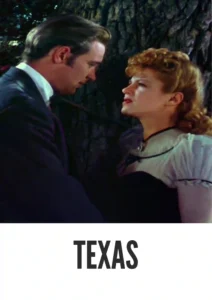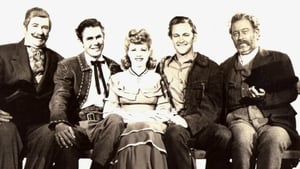Contact: info@alwanfilm.com
Video Sources 0 Views

Synopsis
Texas 1941 Colorized Review: A Classic Western with a Touch of Humor

Introduction
The year 1941 was a pivotal moment in American cinema, marked by the release of several iconic films that would go on to define genres and set trends for years to come. Among these is Texas, a Western comedy-drama directed by the renowned George Marshall. Starring the charismatic duo of William Holden and Glenn Ford, Texas offers a delightful mix of action, romance, and humor, all set against the rugged backdrop of the American West. In this article, we will delve into the significance of Texas (1941), exploring its story, characters, and the innovative techniques that make it a classic of its era.
Check The Full Colorized Movies List
Check Our Colorized Movies Trailer Channel
Understanding Texas 1941 Colorized: Director, Cast, and Genre
Director’s Vision
George Marshall, an accomplished director known for his versatility across various genres, brought Texas (1941) to life with his characteristic flair. Marshall’s vision was to create a film that not only captured the adventurous spirit of the Wild West but also infused it with elements of comedy and romance. His ability to balance action with humor allowed Texas to stand out among the many Westerns produced during this period.
The Iconic Performance of Actors
At the heart of Texas are two of Hollywood’s leading men, William Holden and Glenn Ford. Holden, who plays the dashing character of “Brett,” delivers a performance filled with charm and charisma. His portrayal of a rugged cowboy navigating love and rivalry resonates with audiences and adds depth to the film.
Glenn Ford, in the role of “Brett’s rival,” provides a compelling counterpoint to Holden’s character. Ford’s strong screen presence and ability to convey emotion bring complexity to the narrative, making their rivalry both entertaining and engaging. The chemistry between Holden and Ford is palpable, contributing to the film’s overall appeal.
Exploring the Genre
Texas (1941) falls into the Western genre, a category that experienced immense popularity during the 1940s. Westerns typically showcase the struggles and triumphs of rugged individuals in the untamed frontier, often emphasizing themes of justice, honor, and adventure. However, Texas sets itself apart by incorporating comedic elements and a light-hearted tone, allowing it to appeal to a broader audience.
Exploring the World of Texas 1941 Colorized: Plot and Characters
Detailed Synopsis
Texas (1941) follows the journey of two friends, “Brett” (William Holden) and “Brock” (Glenn Ford), who are determined to establish their own ranch in the burgeoning state of Texas. The film opens with the two men embarking on their adventure, filled with dreams of wealth and prosperity. However, they quickly discover that the path to success is fraught with challenges, including rival ranchers, bandits, and their own personal ambitions.
As they navigate the trials of frontier life, Brett and Brock encounter a spirited woman named “Maggie” (played by the talented and beautiful Claire Trevor), who becomes a central figure in their lives. The dynamic between the three characters creates a rich narrative filled with tension, romance, and comedic moments. Their interactions and evolving relationships provide the film with its emotional core.
Key moments in the film include thrilling shootouts, comical mishaps, and dramatic confrontations, all leading to a climactic showdown that tests the bonds of friendship and love. The story is both engaging and entertaining, making it a memorable entry in the Western genre.
The Complex Protagonists and Memorable Supporting Characters
Texas features a cast of supporting characters that enrich the story and contribute to its overall charm. Claire Trevor’s portrayal of Maggie brings depth to the film, as she embodies both strength and vulnerability. Her character is integral to the plot, influencing the decisions and actions of the two male leads.
Other notable characters include local ranchers, bandits, and townsfolk, each contributing to the vibrant tapestry of life in Texas during the 19th century. The interactions among these characters help to highlight the social dynamics of the time and add layers to the narrative.
The Art of Filmmaking in Texas 1941 Colorized
Cinematic Techniques and Innovation
Texas (1941) showcases the technical advancements in filmmaking during its era. The film employs dynamic cinematography to capture the vast landscapes of the Texas frontier, enhancing the sense of adventure and exploration. The use of vibrant Technicolor adds depth to the visuals, making the scenery come alive on screen.
Additionally, Marshall’s direction incorporates innovative editing techniques to create a fast-paced narrative that keeps audiences engaged. The blend of action and comedy is expertly balanced, ensuring that the film appeals to a wide range of viewers.
The Evolution of Westerns: A Brief History
Westerns in the Early 20th Century
The Western genre has a rich history that dates back to the early 20th century, evolving through various forms of storytelling and cinematic techniques. Initially, Westerns were often silent films, featuring heroic cowboys and their battles against outlaws. As technology advanced, so too did the storytelling methods, leading to the emergence of sound and color in films.
By the 1940s, the Western genre had become a staple of Hollywood, characterized by larger-than-life characters, dramatic landscapes, and themes of justice and adventure. Films like Texas (1941) contributed to the genre’s evolution by blending elements of comedy and romance, creating a more nuanced portrayal of life in the West.
Texas 1941 Colorized: Significance and Impact
Cultural Significance
Texas (1941) holds cultural significance as it reflects the changing attitudes and values of American society during its time. The film’s focus on friendship, loyalty, and the pursuit of dreams resonates with audiences, making it relatable and timeless. Furthermore, its portrayal of strong female characters challenges traditional gender roles, offering a more progressive perspective for its era.
The film also contributed to the ongoing fascination with the American West, inspiring future filmmakers to explore similar themes and narratives. Its blend of comedy and drama paved the way for subsequent Westerns that sought to balance entertainment with deeper emotional resonance.
Director’s Cinematic Legacy: Beyond Texas 1941 Colorized
George Marshall’s Influence
George Marshall’s career extended far beyond Texas (1941), encompassing a wide range of successful films across different genres. Known for his ability to adapt to various styles, Marshall left an indelible mark on Hollywood. His contributions to the Western genre, in particular, showcased his talent for blending action, humor, and compelling storytelling.
Marshall’s influence can be seen in the works of future directors who sought to capture the spirit of the West while incorporating innovative narrative techniques. His legacy continues to inspire filmmakers today, serving as a reminder of the importance of storytelling in cinema.
Themes Explored in Texas 1941 Colorized
Friendship, Loyalty, and Ambition
At its core, Texas (1941) explores themes of friendship, loyalty, and ambition. The relationship between Brett and Brock serves as the backbone of the story, highlighting the bonds that can be formed through shared experiences and challenges. Their journey is not only about establishing a ranch but also about navigating the complexities of friendship and rivalry.
The film also addresses the ambition that drives individuals to pursue their dreams, often at great personal cost. Brett and Brock’s determination to succeed in the face of adversity reflects the broader American spirit of resilience and tenacity, making it a resonant theme for audiences of all ages.
Reception and Controversy Surrounding Texas 1941 Colorized
Initial Reviews and Audience Reactions
Upon its release, Texas (1941) received mixed reviews from critics, with many praising the performances of Holden and Ford, as well as the film’s engaging storyline. Audiences responded positively to the film’s blend of action and humor, enjoying the light-hearted tone and entertaining characters.
However, some critics noted that the film’s comedic elements occasionally undermined the seriousness of the Western genre. This divide in opinion reflects the ongoing debate within the film industry about the direction of Western storytelling and the balance between humor and drama.
Where to Watch Texas 1941 Colorized Online
For those interested in experiencing Texas (1941), several streaming platforms provide access to the film. Services such as Amazon Prime Video, Apple TV, and Tubi TV offer options for viewing the film online. Additionally, DVD and Blu-ray versions of the film are available for purchase, allowing fans to enjoy this classic Western at home.
FAQs About Texas 1941 Colorized
Q: What makes Texas (1941) unique in the Western genre?
A: Texas (1941) is unique in its blend of comedy and drama, offering a light-hearted take on the Western genre while still addressing themes of friendship and ambition.
Q: Who directed Texas (1941)?
A: Texas (1941) was directed by George Marshall, a well-respected filmmaker known for his versatility across various genres.
Q: What themes are explored in Texas (1941)?
A: The film explores themes of friendship, loyalty, and ambition, emphasizing the importance of relationships and the pursuit of dreams.
Q: How was Texas (1941) received by audiences and critics?
A: Upon its release, Texas (1941) received mixed reviews, with many praising the performances and engaging storyline while others noted that its comedic elements occasionally detracted from the seriousness of the Western genre.
Conclusion
Texas (1941) stands as a testament to the evolution of the Western genre, offering a delightful mix of action, romance, and humor. Directed by George Marshall and featuring memorable performances from William Holden and Glenn Ford, the film captures the spirit of the American West while addressing timeless themes of friendship and ambition. Its cultural significance and innovative storytelling techniques contribute to its status as a classic of its era. Whether viewed for its comedic charm or its engaging narrative, Texas remains a beloved film that continues to resonate with audiences today.











